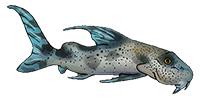https://onlinelibrary.wiley.com/doi/abs ... /jfb.14131
https://doi.org/10.1111/jfb.14131
PDF:https://onlinelibrary.wiley.com/doi/epd ... /jfb.14131
This article has been accepted for publication in the Journal of Fish Biology and undergone full peer review but has not been through the copyediting, typesetting, pagination and proofreading process, which may lead to differences between this version and the Version of Record. Please cite this article as doi: 10.1111/jfb.14131.
Abstract
We analysed the influence of ecological factors, phylogenetic history and trade‐offs between traits on the life‐history variation among ten loricariid species of the middle Paraná River. We measured eight life‐history variables and classified the life‐history strategies following the equilibrium–periodic–opportunistic (EPO) model. Principal‐component analysis of life‐history traits segregated species along a gradient from small opportunistic (low fecundity, low parental investment) to large equilibrium (low‐medium fecundity, high parental investment) species. A clear periodic strategist was absent in the analysed assemblage. Variation partitioning by canonical phylogenetic ordination analysis showed both a component of variation uniquely explained by phylogenetic history (PH; 32.2%) and a component shared between PH and ecological factors (EF; 37%). The EPO model is a useful tool for predicting correlations among life‐history traits and underst anding potential demographic responses of species to environmental variation. Life‐history patterns observed throughout Loricariidae suggests that this family has diversified across all three endpoint strategies of the EPO model. Our study indicates that evolutionary lineage affiliation at the level of subfamily can be a strong predictor of the life‐history strategy used by each species.




